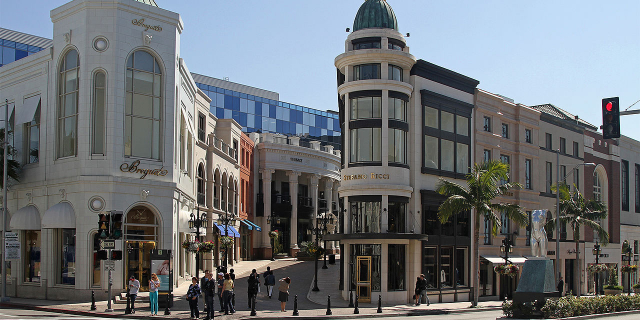Griffith Observatory
Griffith Observatory is an observatory in Los Angeles, California, on the south-facing slope of Mount Hollywood in Griffith Park. It commands a view of the Los Angeles Basin including Downtown Los Angeles to the southeast, Hollywood to the south, and the Pacific Ocean to the southwest. The observatory is a popular tourist attraction with a close view of the Hollywood Sign and an extensive array of space and science-related displays. It is named after its benefactor, Griffith J. Griffith. Admission has been free since the observatory's opening in 1935, in accordance with the benefactor's will.
Over 7 million people have been able to view through the 12-inch (30.5 cm) Zeiss refractor since the observatory's 1935 opening; this is the most people to have viewed through any telescope. The space theme prevails in the interior.
On December 16, 1896, 3,015 acres (12.20 km2) of land surrounding the observatory was donated to the City of Los Angeles by Griffith J. Griffith.[1] In his will Griffith donated funds to build an observatory, exhibit hall, and planetarium on the donated land. Griffith's objective was to make astronomy accessible to the public, as opposed to the prevailing idea that observatories should be located on remote mountaintops and restricted to scientists.[2]
Griffith drafted detailed specifications for the observatory. In drafting the plans, he consulted with Walter Sydney Adams, the future director of Mount Wilson Observatory, and George Ellery Hale, who founded (with Andrew Carnegie) the first astrophysical telescope in Los Angeles.[2]
As a Works Progress Administration (WPA) project,[3] construction began on June 20, 1933, using a design developed by architects John C. Austin and Frederic Morse Ashley (1870-1960), based on preliminary sketches by Russell W. Porter.[1] The observatory and accompanying exhibits were opened to the public on May 14, 1935, as the country's third planetarium.[4] In its first five days of operation the observatory logged more than 13,000 visitors. Dinsmore Alter was the museum's director during its first years.
The building combines Greek and Beaux-Arts influences, and the exterior is embellished with the Greek key pattern.[5]
During World War II, the planetarium was used to train pilots in celestial navigation. The planetarium was again used for this purpose in the 1960s to train Apollo program astronauts for the first lunar missions.
Griffith Observatory FoundationGriffith Observatory Foundation was chartered in 1978 as Friends Of The Observatory. It was founded by Debra Griffith and Harold Griffith (the grandson of the observatory's benefactor) with Dr. E.C. Krupp (the current Observatory Director) and a small group of dedicated partners. The foundation supports the observatory in its mission of public astronomy and advocated the restoration and expansion of the observatory. The foundation continues to promote the observatory as an agent of science literacy, education, and experiential astronomy.[citation needed]
Renovation and expansionThe observatory closed on January 6, 2002 for renovation and a major expansion of exhibit space. It reopened to the public on November 2, 2006, retaining its Art Deco exterior. The $93 million renovation, paid largely by a public bond issue, restored the building, as well as replaced the aging planetarium dome. The building was expanded underground, with completely new exhibits,[6] a café, gift shop, and the new Leonard Nimoy Event Horizon Theater.[7]
On May 25, 2008, the Observatory offered visitors live coverage of the Phoenix landing on Mars.[8]
Ed Krupp has been the director of the Observatory since 1974. He has been responsible for updating the technology and the building for over 45 years.[9]






































Add new comment